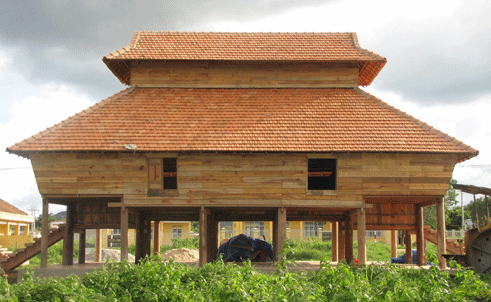 |
| The communal house in Đắk Mế Commune in Kon Tum has been built using the state budget (Photo: www.congan.com.vn) |
(VOVworld) – The Central Highlands province of Kon Tum is home to 588 communes of ethnic minorities still facing many difficulties. Over the last years, thanks to local aid, 505 communal houses have either been restored or newly built and have become cultural centers for village communities. The success of the restoration project has become a suggestion for the province to encourage villagers simultaneously adopt a new rural development program.
Kon Tum province is home to Xedang, Ba Nar, Gie Trieng, Gia Rai, B’rau and Romam ethnic minorities whose communal houses are their pride representing their force of energy, will, and a place for local activities to take place. Musician A Du from Ba Nar group, Vice Head of the provincial Art Troupe, says ‘A communal house is the soul of a commune, and a place for gathering. When something happens, from the communal house, the village patriarch will give villagers the signal to know whether it’s a good or bad news. At the communal house, village young men will participate in competitions to show off their talents or skills’.
From 1990 to 2000, communal houses weren’t maintained in many villages in Kon Tum. Following the Party’s resolution on creting new rural areas, Kon Tum attached special importance to restoring communal houses to preserve the community cultures of local ethnic minority people. A Huya from Plei Don Village in Kon Tum city says that to build a communal house of up to 18 meters high and 60 square meters wide, it requires tens of cubic meters of wood and thousands of workdays. A Huya says ‘It’s getting more and more difficult to be able to complete a communal house for lack of wood. It’s hard to find enough timber. The forests are many kilometers away and sometimes, require staying for a week sleeping there at night to look for enough materials. The transportation of the wood is another tough job’.
Despite the hardships, the restoration has seen an active and voluntary response from the locals. To date, the number of communal houses has doubled since 2000, now counting 265. Bui Thi Thanh Van, Director of the provincial Department of Culture, Sports and Tourism, says ‘In my opinion, the construction has been well implemented with all funding donated from various sources of society. To give an idea of cost, it costs 50 million VND or 2,400 USD to build the smallest communal house and 380 million VND or more than 18,000 USD for the largest house. On average, it takes up to 1.2 million USD to build more than 500 houses’.
The success of restoration of traditional communal houses suggests the province to mobilize local villagers to simultaneously carry out the program on new rural development. The program is under way in 81 communes, many which them are home to 100% of ethnic minority people. Deputy Director of the provincial Department of Information and Communication, Tran Vinh has spent years studying cultural traditions of local groups here saying ‘We need to combine cultural characteristics in every element of the new rural development program to attract the participation of ethnic minorities. If a program simply focuses on the social welfare aspects, it will be hard to gain their support as their awareness of the impact the program can have is still low. The model to restore communal houses demonstrates that traditional cultural characteristics must be a fundamental part in the new rural development programs if we want local ethnic people to take part voluntarily’.
Khoa Diem VOV